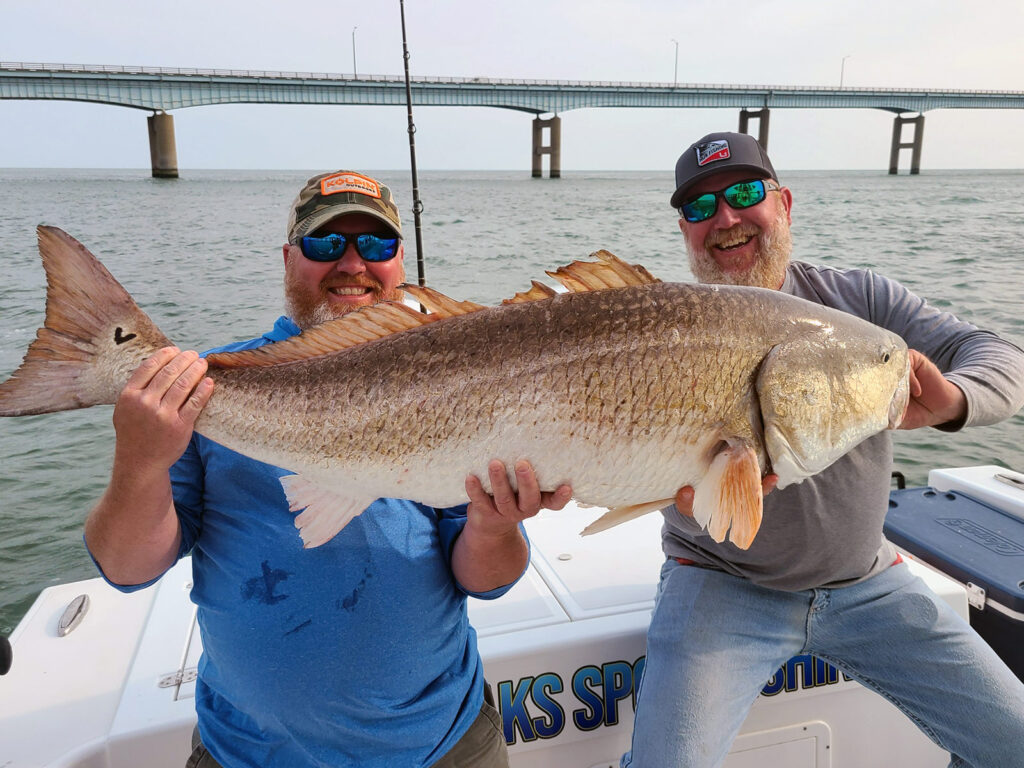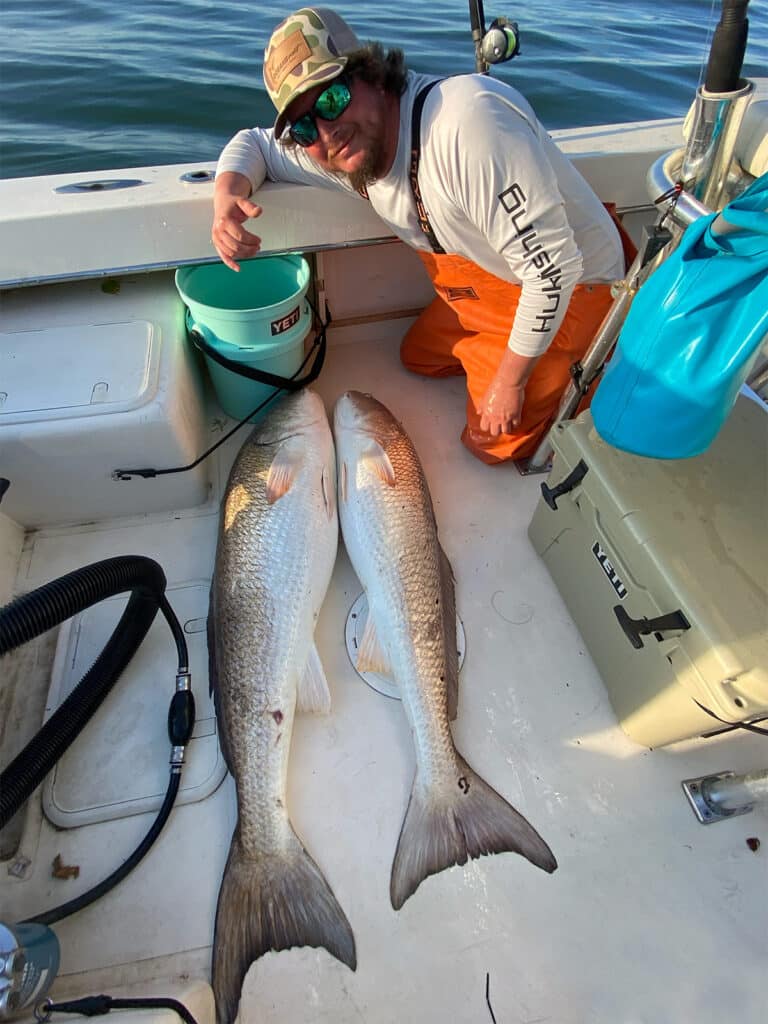
Big red drum school along the shore and on shallow shoals and channels at the mouth of Chesapeake Bay. Captain Kenny Louderback, of Fish Freaks Guide Service, expects fishing to improve as water temperatures rise into the 70s. Captain Kenny Louderback “The fishing was so good, I could only fish two rods and I was getting worn out,” reported Capt. Kenny Louderback after a recent trip where he landed 23 giant redfish between 44 and 48 inches. “The day before we caught redfish up to 53 inches!”
Capt. Kenny Louderback was fishing shallow shoals at the mouth of Chesapeake Bay and along Fisherman Island on Virginia’s Eastern Shore.
The day of the epic bite, he marked fish on his fishfinder in 30 feet of water and deployed the anchor. The deep hole was close to shore making a natural funnel for the redfish to travel into the surf zone.
With two anglers steadily cranking in giant redfish, Louderback was busy baiting hooks, landing drum and reviving the released fish. “Before I release a redfish, I use a fish gripper to hold it in the water,” he explained. (Don’t hold a fish vertically with a lip gripper.) Once the fish swims on its own, he unclips the gripper and lets the red swim free. The captain laughed, “As soon as the bait hit the bottom, I’d have two more fish to release.”
How to Catch Chesapeake Bay’s Red Drum

Fishing with a whole or half hard crab on a 9/0 hook and 50-pound leader, Louderback uses a fish-finder rig with 8 to 10 ounces of lead. To fish the heavy rig and big bait, he utilizes a 6-foot boat rod and PENN Squall 20 spooled with 30-pound braided line. He threads a fish-finder slide over the mainline and ties the line to a swivel. The swivel is connected to one to three feet of 50-pound monofilament and the 9/0 circle hook.
Up until recently, red drum fishing has been slow. Louderback reports cold water and bad weather are putting a damper on the red drum bite. “A hard northeast wind has caused the water temperature to fluctuate.” He sees 68 degrees one day and 64 degrees the next day. Since the water temperature started to stabilize, Louderback has had consistent action on big red drum. With the slow start, he hopes for a longer season as the water warms into the lower- to mid-70s.
In a couple weeks, Louderback will turn his attention to sight fishing for cobia and red drum. He searches the mouth of Chesapeake Bay looking for the schools of redfish and cobia swimming on the surface. When he spots fish, he casts a two-ounce bucktail or live eel with a medium-heavy spinning rod and reel. He looks for sight fishing to continue through summer and into early fall.
Outer Banks Redfish Fishing Techniques

Farther south, North Carolina’s Outer Banks have been covered up with trophy red drum since February. “Red drum fishing is awesome,” said Capt. Tim Hagerich, from the Black Pearl Charters out of Hatteras Inlet. When I texted Hagerich for a fishing report, he replied, “I’m on a school of drum right now!”
Hagerich finds drum two ways. When the weather is clear and the seas calm, he heads into the ocean toward Diamond Shoals. Searching the shoals, he finds schools of drum in the clear water. “Sometimes the school has 2,000 fish,” he marveled.
Once he spots a school, Hagerich casts a 2-ounce bucktail toward the fish. “Jig the bucktail anywhere near the school and the fish will pile on,” he explained.
Hagerich stopped using the ubiquitous rubber curly tail jig on his bucktail. “It takes too much time to fix the tail after catching a fish,” he complained. Hagerich said it’s more important to cast again while the school is nearby. “Bucktail color doesn’t matter, either,” he added.
Big Red and Black Drum Mixed Together
On a recent trip, Hagerich found big redfish mixed in with a school of large black drum. The water on Diamond Shoals was crystal clear and Hagerich spotted a school of black drum in 20 feet of water.
“Black drum won’t bite so I drove around the school four times and didn’t make a cast,” he recalled. Another captain took a chance and pulled a redfish out of the black school. Hagerich chuckles and said, “The moral of the story is don’t believe your eyes.”
Wind, What Wind? When the wind blows, Hagerich fishes behind the islands. “The harder the wind blows, the fishing gets better,” he said.
Focusing his efforts on Hatteras Inlet, Hagerich finds breaking waves on a shallow shoal and anchors his boat. He casts a chunk of mullet on a fish-finder rig into the breakers and along the deeper slough. Fishing in the wind is no problem: “We fished three days in 30-knot winds last week,” he said.
Hagerich expects drum fishing to remain good through the summer and into fall. As the water warms, he turns his attention to slot and over-slot redfish on the grass beds and shallow flats.








